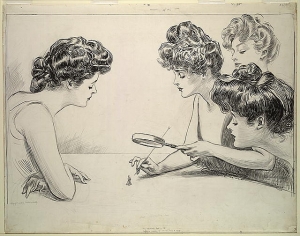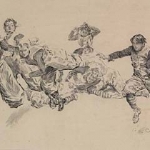
Charles Dana Gibson (1867-1944)|The Weaker Sex II, 1903|Illustration for Collier's Weekly v. 31 (July 4, 1903): 12-13|also one of the illustrations for Gibson’s Eighty Drawings featuring The Weaker Sex: The Story of a Susceptible Bachelor (New York: Scribner’s, 1903)|Ink on paper|Cabinet of American Illustration (Library of Congress). Accession no. DLC/PP-1935:0140
Gibson Girls were lots of things: healthy, charming, athletic, white Anglo-Saxon Americans, and most assuredly, beautiful. Charles Dana Gibson’s images of women inspired “. . . costumes and hairdos” and promoted “the image of the athletic girl who played tennis and golf, rode horseback, swam, and bicycled,
As we can see, Gibson was a master of the drawn line, but it was always in the service of creating wonderful pictures. His first foray into the art world was by way of his youthful penchant for cutting silhouettes, something he had learned to do as a child. The leap into drawn illustrations from silhouettes makes perfect sense if you think of the lines revealed by cut paper edges. He believed that line drawing was the most direct form of pictorial expression and he used that belief to propel his images of American life.
While American culture has identified one rather rarified type that came from his pen in the form of the Gibson Girl, visual evidence yields another. Gibson not only illustrated the refined upper class woman, he also provided views into the new avenues opening up for women in the early years of the twentieth century. For example, he showed us, a young woman in bloomers riding a bicycle to advertise a new issue of Scribner’s Magazine in 1896; illustrations for a story about a girl’s life as an artist in Paris; and a futuristic illustration of young Vassar women in bloomers playing football against Yale’s young men (see below).

Charles Dana Gibson (1867-1944)|The Coming Game: Yale vs. Vassar, 1895|Illustration for Life republished on the front page of The San Francisco Call (November 24, 1895)|Ink on paper
Thoughtful biographers recognized early on that Gibson showed us the breadth of life possible for women in this new century. As Robert Bridges described him in a Collier’s article, “Mr. Gibson has drawn not a few types, but a great many individuals; not the social butterflies alone, but the significant people in all grades of life; not only beautiful women in gorgeous raiment, but all types of women in all classes.”** Indeed Gibson could be called an artist of turn-of-the-century American democracy. It is possible that Gibson used his pen to set up and play type against type, challenging his fans to reorient their own perceptions about roles for men and women. It may be that his Gibson Girl was not produced as the era’s ideal, but merely as an expression of one sort of woman.
* Dictionary of Literary Biography, Documentary Series: The House of Scribner 1846-1904, An Illustrated Chronicle, Volume 13
** Robert Bridges, “Charles Dana Gibson” Collier’s Weekly Magazine (October 15, 1904)
November 19, 2009
By Joyce K. Schiller, Curator, Rockwell Center for American Visual Studies
Norman Rockwell Museum






